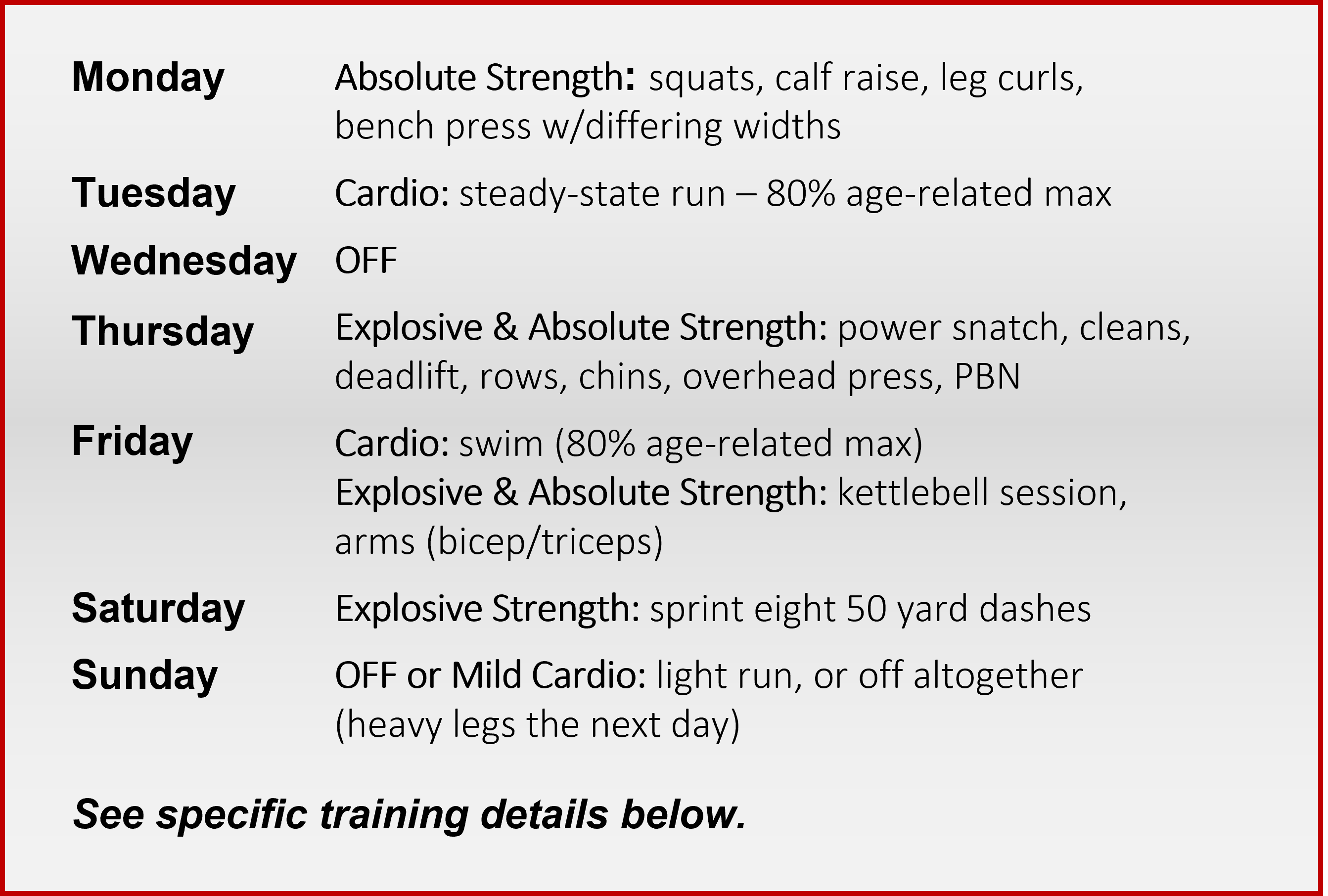
King Strength - The predominant bio-motor attribute: integrate the three strength types using non-conflicting programing.
Both physique and performance improve when measurable performance in one or more of the five bio-motor attributes improves. i.e., strength, speed, endurance, flexibility, agility. Strength is the predominant bio-motor attribute on account of strength bleeds over into speed: there is no speed without strength. Sprint acceleration demands strength. Top end sprint speed is constructed in the same way raw power and strength are built: a 102% of capacity training session is undertaken when the athlete is 100% rested. To improve speed or strength undertake an all-out effort when totally rested.
In the 1970s, Charlie Francis, the great Canadian sprint coach, was the first westerner to adopt the “rested effort” methodology. Iron Curtain coaches in coordination with communist medical professionals and sport scientists created the world’s fastest men and women –by having them run less. Those that sprinted all out every day never ran fully rested, and ergo, never optimized training session potential. No matter how well the sprinter performed, they would have performed better if the identical workout had been taken when fully rested. How could this not be so? Take a read of our recent post on training recovery accelerators.
Strength training differs from bodybuilding. The goal of strength training is to build usable athletic strength, any muscle the strength trainer constructs is purely coincidental. The goal of bodybuilding is to inflate, enlarge, engorge, a targeted muscle. Done repeatedly, and over time, the targeted muscle grows larger. Any concurrent increase in strength is purely coincidental. Within the universe that is strength training there are three definable types of strength. We define this as "Functional Strength."
Maximum payloads are pushed or pulled for short distances with no regard for velocity. Low repetition sets are favored. Full range-of-motion movements done with maximum poundage using short-stroke movements builds low-end torque, power, and maximum muscle mass.
Moderate payloads are moved with maximum velocity for (relatively) long distances. The goal is to accelerate the payload. Sprints, kettlebell drills, MMA drills, Olympic weightlifting, all are expressions of explosive strength, explosiveness is horsepower, as opposed to powerlifting’s torque.
Strength endurance, i.e., sustained strength, enables the athlete to put out a high level of power for extended periods without “gassing out.” Sustained strength injects purposeful muscular contractions into an aerobic format. Sustained strength protocols build mitochondrial density.
Learn more about "What is Functional Strength?" and exercises you can incorporate into your training regimen in the post below.
Legislating the Programming Blend
The total athlete pays homage to all three strength types, i.e., optimally we include all three types of strength training within the same training week. The challenge is to avoid over training and/or “conflicting” programming. For example: squatting all out the day before a scheduled sprint session will kill sprint results. You do not want to destroy the quick lift ability (explosive strength) by doing the quick lifts after heavy deadlifting or rowing. The spacing and pacing is critical.
Sustained Strength does double duty
A fitter, leaner athlete has the advantage over an obese opponent. A low body-fat percentile makes for a superior athlete: better to be a 200 pound athlete with a 10% body fat percentile than a 200 pound athlete with a 20% body fat percentile. Body composition is leveraged by skillfully combining consistent aerobic exercise with a sophisticated nutritional approach. One clever training wrinkle is to “kill two birds with one stone." Use sustained strength, AKA strength-endurance drills, as the cardio protocol. Select cardio drills that are also sustained strength drills. Here is one example of a training split that covers all three strength training bases to strike the programming balance.

Mon
Calf raises are followed by lying leg curls and then squats in a tri-set. Squats may be freehand goblet, front, hi-bar, or low-bar. 3-5 leg tri-sets, depending on strength level. Now onto barbell flat bench: start with your strongest grip, the competition-grip, touch-and-go style. Reduce the weight 20 pounds, now one set of competition-grip benches paused. Reduce 20 pounds again, now narrow grip touch-and-go. Reps will vary. Below is a post on our signature squat style.
Tues
Any type of steady-state exercise that generates a 75% to 80% heart rate; ride a cardio device, jog-run, swim, whatever mode you select, the idea is to get into a steady state “zone.” Steady state cardio improves fitness flushes toxins, improves organ function, burns calories and, if done right (not too hard, not too easy) accelerates recovery while improving endurance. Below is a post about different cardio states.
Wed
Off - no training of any kind
Thurs
Commence with power snatches, two rep sets; do these first, when the central nervous system is fresh, never bury the quick lifts deep into a lifting session. Power cleans follow. When the velocity on the second rep slows, shift to deadlifting, no more than 5 reps on the top set. Overhead front presses are taken out of the squat rack. Knock off 20-30 pounds. One set to failure in the press-behind-the-neck.
Fri
Some sort of steady-state activity. I like swimming as I find the cool water therapeutic and anti-inflammatory. Follow with some sort of short (15-20 minutes) explosive drill. Kettlebells flung properly are wonderful explosive strength tools. A second arm training session is optional: if undertaken, no more than three super-sets with reps in the 8-10 rep range. I like to do the drills first, then swim.
Sat
Reserved for speed, eight reps of 100% effort using whatever mode you choose. The athlete could perform eight sprints on a cardio device, a stationary bike, Nordic trac, stair-stepper. I prefer outdoor sprinting. Regardless the mode selected, the protocol is the same: go all out, recover, go all out again, i.e., sprint, recover, sprint again. Athletes new to sprinting should start with 3-4 all out efforts, work up to eight over time. For winter time cardio a stationary bike can be used in a proscribed fashion using different drills to burst activity and then rest. Check out this post on stationary bike drills.
Sun
Rest day. If the athlete feels restless, a light run, or easy swim is allowed. Any exercise done on this day should be mild as this day are considered an “active rest” day. The iron curtain athletes were the first to use light exercise to gently flush toxins and waste products while accelerating recovery. Too much too hard on Sunday will adversely effect Monday’s heavy leg day that kicks off the next week’s training.
The next level: all these strategies, all this balance, needs to be set into forward motion using periodization, i.e., have an overarching game plan that is broken down into weekly mini-goals in a variety of exercise categories. Periodization is another word for preplanning: strength is incrementally increased each week. Increasing reps or poundage improves physique, assuming the nutritional element is not counterproductive. You can learn about periodization from the posts below to set up your own schedule.
Learn more about our philosophies check out our site Functional Strength Join the community sign up below to our newsletter and receive our FREE Planning and Periodization Guide. Please feel free to send us a question here or leave a comment below.
Want the inside training scoop?
Join The Community
Our email content is full of value, void of hype, never pushy, and always free. As a BONUS you will receive our FREE planning & periodization template to help you with your training goals.








[…] Functional Strength Training Program […]